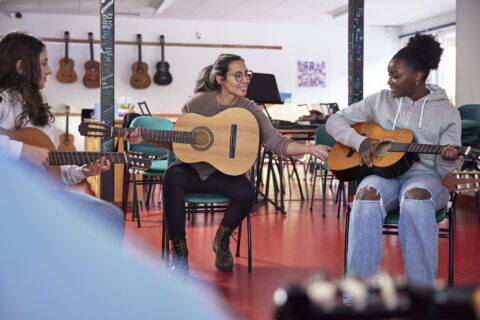On June 30, 2025, the U.S. Department of Education notified grantees that they would be withholding $6.8 billion in K-12 funding that was scheduled to be distributed on July 1. The Department noted that funds are being withheld while the Department conducts a review of FY 2025 funding. This review is typical when changes in administrations happen; however, the timing of this review coincides with an important disbursement timeline as school districts prepare for the start of the upcoming school year.
Funds currently under review include:
- Title I-C for migrant education ($375 million)
- Title II-A for professional development ($2.2 billion)
- Title III-A for English-learner services ($890 million)
- Title IV-A for academic enrichment ($1.3 billion)
- Title IV-B for before- and after-school programs ($1.4 billion)
While many cities, towns and villages do not control their local school system, they are deeply involved in the afterschool and summer learning programs in their communities. These programs are usually partnerships between school districts, city governments and community-based organizations. The local-federal partnership is essential to these programs to ensure their ongoing operation and support for programs for nearly 1.4 million children in all 50 states annually.
The withholding or reduction of Title IV-B, which authorizes the 21st Century Community Learning Centers (21st CCLC) program, the only federal funding source dedicated specifically to afterschool and summer learning programs, would have a significant impact for cities where programs rely on this support. Additionally, this review of funds comes on top of a proposal in the President’s FY 2026 Discretionary Budget Request for the elimination of 21st CCLC funding.
What 21st CCLC Does for Cities
Many urban and rural communities rely on 21st CCLC funding to provide:
- Academic enrichment (tutoring, homework help, reading and math support)
- STEM and career exploration
- Enrichment activities such as sports and arts
- Health and wellness supports, including meals and mental health services
- Safe and supervised spaces for youth during OST hours
These programs, referred to as Out of School Time (OST) programs, are often housed in city community centers or schools and can be operated by cities, local nonprofits, libraries or other community partners. In cities where capacity is stretched, the loss of this funding could impact not just programming but also the infrastructure supporting collaboration among providers.
The Impacts of Federal Funding Cuts
If federal funding continues to be withheld or is eliminated or reduced, cities may experience:
- Program Closures or Reductions: Programs that rely on 21st CCLC grants may reduce hours, limit enrollment or shut down entirely, especially in neighborhoods with limited alternative options.
- Increased Strain on Working Families: Parents who depend on these programs for childcare may have fewer affordable or accessible options, affecting workforce participation.
- Greater Risk of Youth Involvement in Crime: Without safe, structured environments after school, more young people may be unsupervised during peak hours for youth crime and victimization, increasing the likelihood of involvement in or exposure to harmful activities.
- Gaps in Learning and Support: Programs help students build literacy, math and social skills. Their absence could widen academic gaps, especially for students already at risk of falling behind.
- Disrupted Partnerships: Cities often use these funds to align efforts across schools, city departments and nonprofits. The loss of this dedicated stream could weaken those relationships or shift focus to less coordinated and/or short-term grants.
What Cities Can Do Now
While cities don’t control federal appropriations, there are some concrete steps local governments can consider:
- Assess the Local Landscape: Identify which programs in your city receive 21st CCLC funding, how many students are served and what alternatives exist if those funds were to disappear. The City of Denver, Colorado analyzed the impact of a 60% reduction in federal funding for programs across the city and found that this reduction would result in the loss of at least 1500 afterschool program spaces for children and youth. Rhett Gutierrez, Policy Director for Denver’s Office of Children’s Affairs, shared: “Because City funds are not enough to keep programs open on their own, our partners rely on 21st CCLC to fill out the pie that makes up their budgets. We anticipate sustained freezing of these funds will result in either site closures, reductions in slots or a rise in cost for families.”
- Map Funding Ecosystems: Look at how 21st CCLC is braided with other sources, such as Title I, philanthropy and general fund dollars. This can help identify potential areas to reinforce or reallocate in case of funding changes.
- Strengthen Cross-Sector Coordination: Cities with robust OST networks, which often include schools, nonprofits, parks departments and libraries, may be better positioned to adapt. This may be a time to revisit or formalize local OST strategies.
“The City of Glenn Heights, TX is proactively preparing for potential funding cuts by strengthening existing partnerships, making a concerted effort to recruit volunteers, and forging new collaborations with organizations that share its deep commitment to education. These efforts reflect the City’s ongoing commitment to supporting students and families, regardless of fiscal constraints, through community-driven solutions and resilient public services.”
– Mayor Sonja Brown, Glenn Heights, TX
- Consider Interim Solutions: Some cities are exploring other funding streams such as state funding and private partnerships to maintain programs in the short term while monitoring the federal process.
- Engage with State Partners: Because 21st CCLC funds are administered by State Education Agencies, maintaining communication with state officials can help cities stay informed and identify transition supports, if needed.
- Participate in Federal Advocacy Efforts: City leaders have a strong voice in federal advocacy. As Congress begins their FY 2026 process, now is the time to speak out to your members of Congress regarding the importance of 21st CCLC funds and your concerns regarding current and ongoing funding. The House Committee will mark-up their version of the Labor-HHS-Education bill on July 21 and the Senate is expected to consider their version of the bill shortly thereafter.
Looking Ahead
The proposal to cut 21st CCLC funding is not new. Similar attempts have been made in past budget cycles and were ultimately rejected by Congress. However, the current proposal highlights how reliant many communities are on a single funding stream to support youth outside of school hours.
“The loss of Federal funding for the STEAM Academy of Umatilla is devastating and it leaves our community without after-school care for over 700 students each year. As Mayor, I will continue to advocate for reinstatement of these funds and will serve as a partner to the school district as they work to develop alternative solutions to support children and working families,” shared Mayor Caden Sipe of Umatilla, OR.
Regardless of the federal outcome, now is the time for cities to evaluate how afterschool and summer learning fit into broader youth development strategies and municipal priorities, and determine what’s needed to build more resilient, locally supported systems for the future. For more information on advocacy efforts or to share your stories of impact, contact educationandworkforcesuccess@nlc.org.
Explore More Afterschool and Summer Learning Resources
NLC has more than 20 years of experience and knowledge working with cities and municipal leaders to help strengthen local efforts to create, expand, and improve afterschool and summer learning opportunities. Through these efforts, municipal-led, citywide afterschool systems and quality summer learning programs have developed across the nation. Visit the resource hub to find more resources that will help you grow the afterschool and summer learning programs in your community.








